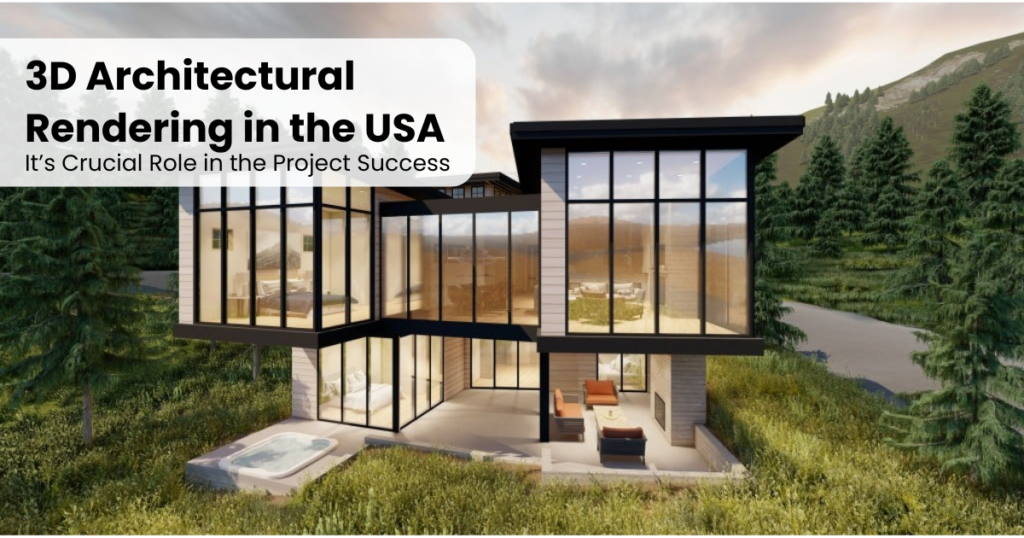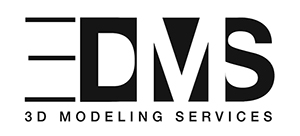
Architects utilize 3-D rendering services mainly to create a compelling project presentation. The best way to inform clients is to display photorealistic images of ideas. In this way, architects, their clients, and other stakeholders can “speak the same language” and achieve mutual understanding without any issues.
Architects and designers are increasingly using 3D rendering as a crucial tool for undertaking success as projects get more complicated and client expectations rise. Let’s learn how important 3D architectural rendering in the USA is to making designs come to life and guaranteeing task completion in the USA.
3D Architectural Rendering in the USA: It’s Crucial Role in the Project Success
1. Enhancing Communication and Collaboration
3D architectural rendering plays a crucial role in enhancing conversation among project stakeholders. Converting complicated thoughts via 2D drawings often results in misunderstandings and misinterpretations in conventional design procedures. Clients, contractors, and investors may also struggle to visualize the last product based solely on blueprints.
With 3D renderings, architects can present their designs fascinatingly and understandably. This readability helps bridge the gap between technical jargon and layman’s terms, permitting all parties to grasp the venture’s rationale. Furthermore, 3-D models can be easily shared through virtual platforms, facilitating collaboration among team members and customers, irrespective of their area.
2. Streamlining Design and Approval Processes
Due to the iterative process of layout, numerous adjustments are frequently made, mostly in response to buyer feedback. Changes made via traditional methods can be costly and time-consuming, particularly if they take place in the development phase. However, quicker adjustments are possible with 3D architecture rendering, enabling designers to explore various choices quickly.
Architects can create fresh representations in just a fraction of the time required to edit traditional designs when a client demands changes. This adaptability ensures that clients fully understand the suggested changes while also expediting the design process. This will result in a more efficient work timeframe and quicker approvals.
Searching for “3D architectural rendering services near me,” if yes then 3D Modelling Service is the best alternative for you to enhance your business with 3D renderings and ensure your goal achievement.
3. Marketing and Client Engagement
Effective marketing techniques are essential for attracting clients and landing jobs in the design and construction industry. 3D Architectural Rendering Services in USA are effective marketing tools that help businesses highlight their creative and layout skills.
High-quality renderings can be used in websites, brochures, and social media to generate interest in a company’s services and attract clients. Businesses may stand out from the competition and build a strong brand identity by providing aesthetically pleasing representations of jobs. Additionally, prospective clients can explore concepts in immersive ways using interactive 3D renderings and digital fact stories, which enhances their involvement and sense of connection to the project.
4. Improving Project Visualization
For many customers, the layout can be abstract and overwhelming. It’s difficult to ascertain how a completed building will look and feel based totally on blueprints on my own. 3D architectural rendering addresses this problem by using realistic visualizations that permit clients to enjoy the design before production starts off-evolved.
These renderings can show design features, lighting fixture situations, and customer and material choices to help customers make well-informed decisions. By visualizing the assignment, customers can see possible issues or changes early in the system, guaranteeing that the end product meets their goals and expectations.
5. Facilitating Regulatory Approvals
Managing the regulatory environment is one of the most challenging aspects of any building project. Zoning regulations, building codes, and permit requirements frequently require specific submissions to local authorities. In this sense, 3D architectural renderings can be useful as they offer a thorough and clear visual representation of the planned project.
Excellent renderings can significantly increase the inspiration’s readability when filing designs for approval. Decision-makers can better understand the layout’s impact on the environment, which could also make approvals go more smoothly. This proactive approach to regulatory compliance can help with routine task completion by saving time and money.
The Future of 3-D Architectural Rendering

As technology continues to improve, the destiny of 3D Architectural Rendering Services in USA appears promising. Innovations such as synthetic intelligence and machine mastering are beginning to shape how designers create and present their paintings. Additionally, the upward push of digital and augmented reality is revolutionizing the way customers enjoy designs, including immersive walkthroughs of houses before they’re built.
Moreover, integrating building statistics modeling (BIM) with 3-D rendering improves collaboration and project management. By combining facts and visualization, architects can make extra informed selections and enhance the accuracy of their designs.
Don’t let your ideas stay on paper! Schedule a consultation with 3D Modelling Services and know how our services can enhance your initiatives and captivate your customers. Let’s create something terrific together!
Conclusion
In conclusion, it should be noted that 3D architecture rendering is a revolutionary method essential to the success of architectural projects in the USA. This generation enables architects and clients to work together more effectively by boosting communication, simplifying layout techniques, improving project visualization, and easing regulatory clearances. The importance of 3D rendering will only increase as the business conforms, utilizing creativity and superior layout.
FAQ’s
Q1. What is the difference between 2D and 3D architectural rendering?
Ans: 2D architectural rendering involves flat images and ground plans that lack depth, making it tough to visualize a space fully. In contrast, 3D architectural rendering provides sensible visualizations that permit visitors to experience the layout in three dimensions, along with factors like lights, textures, and substances.
Q2. How can 3-D rendering assist in the creation system?
Ans: 3D rendering facilitates better verbal exchange and know-how amongst stakeholders, considering faster design adjustments, faster approvals, and stepped-forward mission visualization. This, in the long run, results in a more efficient creation process and minimizes pricey modifications during construction.
Q3. Are 3D renderings useful for advertising and marketing purposes?
Ans: Yes, 3D renderings are effective marketing equipment showing an architectural organization’s design skills. They may be utilized in promotional materials, websites, and social media to attract capacity customers and generate interest in a firm’s tasks and services.
